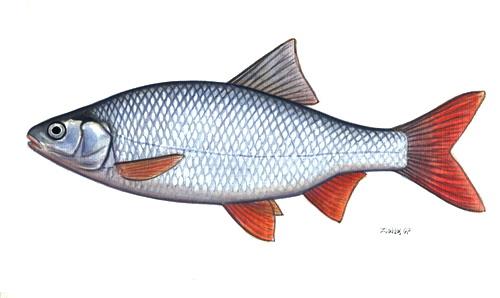Get to Know the Roach: Master of Fast Waters
In the world of freshwater fish, there is one unusual inhabitant that swims among fast waters, standing out with its adaptability and vibrant way of life – the roach, or more commonly known by its scientific name “Rutilus rutilus”. For many, this fish is a symbol of the purity and vitality of flowing ecosystems across Europe.
Appearance and Size
The roach is a slender fish with a silvery or golden-brown color that can vary depending on its habitat. It typically reaches a length of 20 to 40 centimeters, although individuals can grow up to 50 centimeters, especially in optimal conditions.
Habitat and Life Habits
Roach can often be found in fast-flowing waters, such as streams and rivers in mountainous areas. They prefer rocky or gravelly bottoms and are always on the lookout for clean, oxygen-rich waters. They are attracted to the speed of currents, often inhabiting whirlpools and deeper parts of rivers.
Although they are often seen in the company of other fish species such as trout, chub, dace, and barbel, roach mostly lead solitary lives. Only in their youth can they be seen in small groups, especially in areas around river mouths and downstream.
Dietary Habits
Roach are adaptable when it comes to diet. They mainly feed on insects such as flies, beetles, and insect larvae, which they hunt in the middle water layers, especially during daylight hours. In addition, they feed on small crustaceans, small fish, and plant material. Their ability to adapt their diet makes them an important factor in maintaining the balance in freshwater ecosystems.
Fly Fishing Techniques for Roach Fishing
Roach fishing is popular among fly fishermen, and several techniques have proven effective:
- Dry Fly: This technique simulates the flight of insects on the water’s surface. Anglers use lightweight, floating flies that drift on the surface. Roach come to the surface to catch insects, making this experience very exciting for the angler.
- Wet Fly: This technique involves flies that sink below the water’s surface, simulating larvae or adult insects moving towards the surface. Roach will attack this type of fly as it approaches their natural hunting instinct.
- Nymphing: This technique imitates insect larvae swimming in the middle water layers. Anglers use specially designed flies that sink to simulate this stage of insect life. Roach often respond to this type of bait due to their natural feeding habits.
A combination of these three techniques allows the angler to adapt to different water conditions and fish behavior, providing an exciting fishing experience for roach.
Conclusion
In summary, the roach is a fascinating fish that reminds us of the importance of preserving natural waterways. Their adaptability, beauty, and role in the ecosystem make them valuable guardians of our rivers and streams. So, the next time you’re by the bank of a fast-flowing river, pay attention to these elegant swimmers who inhabit beneath the surface. If you’re a fishing enthusiast, try one of the fly fishing techniques to experience the thrill of catching this beautiful fish.

Comments